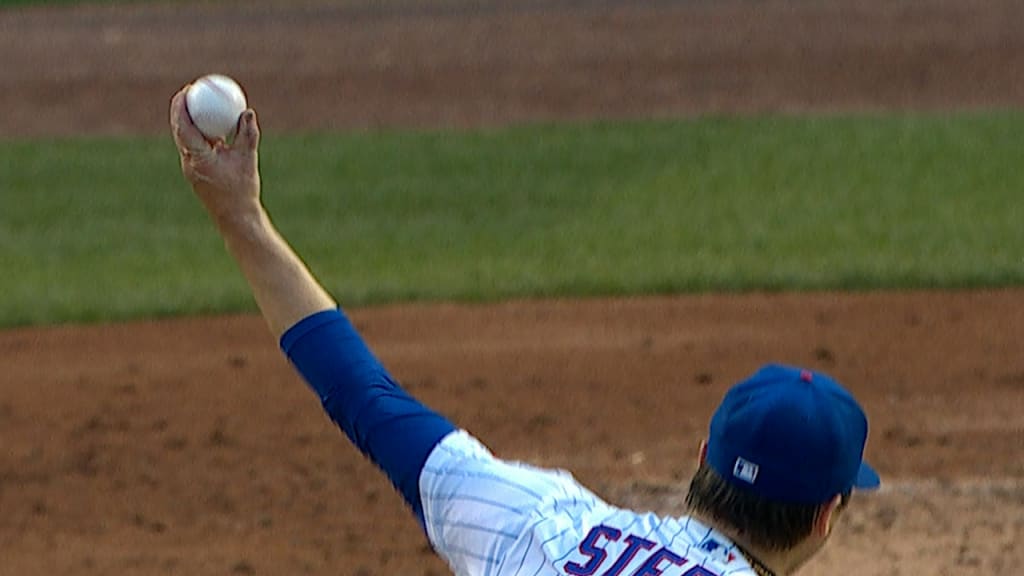Steele ties career high after tip from Lester
This browser does not support the video element.
CHICAGO -- A few days before his start against the Cardinals on Sunday night, Justin Steele was called into his manager’s office to get advice from a fellow southpaw. While watching one of Steele’s previous starts, former Cubs pitcher Jon Lester noticed something he wanted to pass along to his old teammate, Cubs manager David Ross.
“Rossy called me into his office and said Lester called him and had a few tips for me,” Steele said. “One of the main things was establishing the four-seam command, down and in to righties on that inner third of the righties. He said establishing that would kind of open up everything else, and I took that into my next bullpen and was really focusing on that and then took it into the game tonight.”
The Cubs lost to the Cardinals, 5-3 in 11 innings, but Steele was able to take the advice he had gotten from Lester and use it to put together a career-high-tying seven innings. He gave up seven hits but allowed only one earned run.
The first time through the Cardinals’ order, Steele started every at-bat with a four-seam fastball, and 25 of his first 31 pitches were four-seamers.
In all, Steele’s four-seam fastball accounted for just over 70 percent of the pitches he threw Sunday night. Before facing the Cardinals, he had averaged around 55 percent this season and just under 50 percent since breaking into the big leagues last season.
“Going into the game, just wanted to establish four-seam command,” Steele said. “That was kind of my main focus. And while doing that, they were just kind of putting it into play, getting some weak contact with it, so kind of just rode with it.”
The plan, inspired by Lester’s advice, was to establish the fastball early, but as the first and second innings transpired, Steele, Ross and catcher Willson Contreras could see that Steele’s four-seamer was working even better than usual.
“The thing that stood out is the location of them was a little more down. Had some angle to it tonight,” Ross said. “He’s usually trying to go four-seam middle, and the misses have been not competitive, so we made an adjustment, trying to go in a little bit more, and I thought the fact that there were that many fastballs was a good job by him and Willson of noticing there wasn’t a lot of good swings -- lot of soft contact.”
One of the things Ross watches for in his pitchers is how much depth they are getting on their pitches, so how much the angle of the pitch changes from the time it leaves the pitcher’s hand until it crosses through the strike zone. More depth creates less space for a batter swinging on an even plane to make quality contact.
Naturally, then, Ross was taking notice on Sunday when Steele’s four-seam fastball was getting good depth. Going to it so frequently wasn’t a problem for Ross.
“I think we can trick ourselves into going to other stuff because you feel like you’ve thrown too many of one pitch, and I thought they did a good job tonight of sticking with what’s working,” Ross said.
The Cubs have a group of young arms this season, Steele included, that has generated extra energy around the team, even as the Cubs have struggled. Ross has talked about how much he is enjoying working with guys like Steele, Keegan Thompson and the pitchers who started Saturday’s doubleheader, Matt Swarmer and highly touted prospect Caleb Kilian.
But Ross, who spent 15 years as a big league catcher and won World Series rings with the Red Sox and Cubs, said he does not assume that it is a given that these young pitchers know his full resume.
“I don’t know if these guys look at me like I was this long-time big leaguer, but I know Jon Lester carries some weight when you bring that up to a left-handed pitcher,” Ross said. “Being able to share those moments and experiences with guys and tell stories about how they used to pitch and some of the trials they went through and scenarios I think is really good.”
